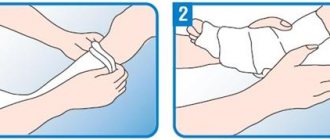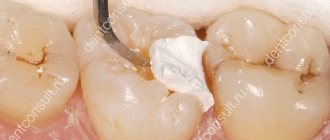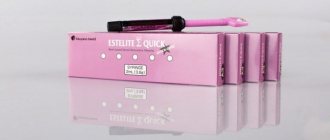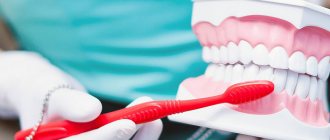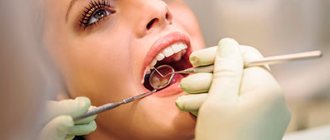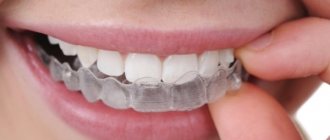In dentistry and orthopedic practice, special types of medical plaster are one of the most common auxiliary materials. In the catalog of offers, which supplies equipment and materials from the world's best manufacturers, dental plaster is represented by the products of the international group of companies Saint Gobain Formula. Samples from the “FORMULA” line of dental plaster, varied in purpose and physical characteristics, of high quality and affordable price, are used in their work by specialized specialists around the world.
In dentistry and orthopedic practice, special types of medical plaster are one of the most common auxiliary materials. In the catalog of offers, which supplies equipment and materials from the world's best manufacturers, dental plaster is represented by the products of the international group of companies Saint Gobain Formula. Samples from the “FORMULA” line of dental plaster, varied in purpose and physical characteristics, of high quality and affordable price, are used in their work by specialized specialists around the world.
Features of production, chemical and physical properties
Explored deposits of gypsum were formed in nature as a result of natural soil filtration of solutions of sulfate salts and weathering of rocks rich in sulfates. For medical use, mineral gypsum, which is an aqueous calcium sulfate salt CaSO4x2H2O, is converted into a “semi-aqueous” state (CaSO4)2xH2O by firing. Crushed gypsum hemihydrate is able to intensively absorb moisture and quickly hardens, returning to the state of a solid mineral.
To obtain gypsum hemihydrate suitable for medical purposes, the extracted natural mineral is crushed using crushing machines and gypsum mills to a homogeneous powder of the finest fractions. At the next stage of the technological process, gypsum is loaded into special ovens and kept at high temperatures for 10-12 hours. By changing the parameters of the firing process, it is possible to obtain gypsum hemihydrates of various strengths and hardening times:
- “α ” gypsum is a dense substance characterized by lower water requirements, but longer setting times and high strength. In the specialized literature, gypsum that is fired at high pressure and temperature in the range of 110°C-115°C is sometimes called autoclave or supergypsum.
- “β ” gypsum is a material with a more developed capillary-porous structure, high water demand and accelerated setting, but lower resulting strength. It is produced at normal atmospheric pressure by firing crushed minerals at temperatures ranging from 95°C to 105°C.
During the production process, harmless natural dyes and modifying additives can be introduced into the composition of crushed mineral raw materials, which can further improve the physical properties of gypsum and, to some extent, change the setting time. This is important, since when mixed with water, gypsum hemihydrate quickly turns into a dihydrate state and hardens, and in many cases it is more convenient to work with a material that has the property of prolonged elasticity and a longer molding time.
What is dental plaster
To understand the essence of what this dental material is, what stages of processing it goes through before starting to manufacture structures from it, it is worth finding out how it differs from natural gypsum and how it is obtained.
The territory of Russia is rich in minerals, including gypsum, the main deposits of which are concentrated in the Tula, Irkutsk regions, Perm and Krasnodar territories.
When mined, it appears as solid crystals of green, pink, yellow or brown. Pure gypsum is colorless, but due to the admixtures of quartz, pyrite, carbonates, and clay, this natural material acquires color. It is extremely rare without impurities.
Before plaster becomes suitable for use in dentistry, it undergoes special processing. It needs to be converted from its natural state - calcium sulfate dihydrate - to calcium sulfate hemihydrate. To do this, the material is crushed to a powder state. The crushing process in the mill is accompanied by simultaneous heating.
Main methods of obtaining:
- under conditions of high pressure - in an autoclave, for 6 hours at a temperature of 120-124 °C. After this, the material is dried, resulting in α-hemihydrate;
- under normal atmospheric pressure - for 12 hours at temperatures up to 165 °C. In this way the β-hemihydrate is obtained.
The resulting powder is carefully sifted and the following is added to its composition:
- catalysts and inhibitors - substances that affect strength characteristics and solidification rate;
- dyes that give a wide variety of colors;
- flavorings (for example, the taste of “mint” - to increase the patient’s comfort).
The essence of the process described above comes down to the fact that as a result the material acquires strength and the ability to set. The finer the powder is ground, the higher these characteristics are. Compliance with the temperature regime is of particular importance: insufficiently high temperatures leave excess water in the plaster, which prevents its hardening.
When the temperature is exceeded, all the water evaporates and anhydride forms, which sets too quickly. If absolutely all the water evaporates when heated, a material is formed that is incapable of setting. After obtaining hemihydrides, dental materials are prepared from them for various purposes.
Composition and technical characteristics
In terms of its composition, dental gypsum is calcium sulfate dihydrate (CaS04 - 2H20). This is a sedimentary rock with a layered crystal lattice, formed by precipitated sulfate salts.
Gypsum is traditionally mined in lakes and lagoons from aqueous solutions through drying. Also, deposits of natural gypsum are found in mountainous areas along with limestones, rock salt, and clays.
Temperature treatment (firing or calcination) transforms the substance into calcium sulfate hemihydrate (CaS04)2 - H20, further heating - into anhydrite.
In dental practice, a semi-aqueous modification of gypsum is used, which has a number of necessary characteristics, namely:
- dimensional stability and accuracy;
- excellent color contrast;
- environmental safety;
- lack of taste and smell;
- insolubility under the influence of saliva;
- low shrinkage rates;
- affordable price.
When choosing an auxiliary material, it is necessary to pay attention to strength indicators, the degree of water absorption, the absence of metal impurities, the proportion of hydration water and volumetric expansion values.
Manufacturers supply gypsum powder in bags made of paper or cellophane impregnated with a water-repellent substance and packaged in jars equipped with ground-in lids. The packaging must contain information about the trade name of the product, information about the manufacturer and supplier, gypsum class, scope of use, color characteristics, net indicators. Also on the packaging there are recommendations about the rules and shelf life, and the batch number.
How do you get the material?
The crystals are colorless and transparent. However, all kinds of impurities, such as clay, pyrite, quartz or carbonate, color them in various shades - from pink to black. To obtain dental gypsum, the material at the first stage is cleaned of impurities and crushed to a powder state.
Next, the natural material is heated to a temperature sufficient to remove some of the water. There are several manufacturing methods. As a result of their use, medical, model plaster and super plaster are obtained. The composition of medical gypsum of all varieties is identical - (CaS04)2 - H20.
The material differs in structure and particle shape:
- The hemihydrate obtained by firing is medical gypsum (β-hemihydrate). The process of its manufacture is heating in an open boiler until some of the moisture evaporates. The material turns out to be porous and loose. Before use in dental practice, the powder is mixed with water in a 2:1 ratio.
- Model plaster (a-hemihydrate) is produced by autoclaving. When mixing non-porous powder with water, the following proportions are used - 5 parts of gypsum particles to 1-1.5 parts of water.
- To obtain super dental gypsum, the boiling method with the addition of chloride (magnesium or calcium) is used. Chlorides act as deflocculants, preventing the formation of flocs and promoting particle separation. When adding water, the traditional ratio is 5:1.
This is interesting: Pros and cons of dental prosthetics without grinding
Video from a specialist:
How does medical plaster work?
For dental purposes, gypsum dihydrate is heated under the required pressure, mixed with water, after which the entire mixture hardens. The degree of hardening of gypsum is influenced by the following conditions: temperature, dispersion, mixing technique, quality and presence of impurities.
For conservative and post-surgical treatment of fractures and soft tissue damage, immobilization with plaster casts is widely used, which is the best means for external fixation of extremity bone fractures.
It is believed that the method of preparing and applying GP was first described by the Dutch physician A. Mathisen (1852), and in 1854, during the Crimean War, it was described and widely used by M.I. Pirogov. He also paid great attention to caring for the condition of the casted limb.
Gypsum quality control
As mentioned earlier, the quality of gypsum is directly proportional to proper firing and other factors - humidity, amount of water for mixing, etc. In connection with these parameters, there is quality control of gypsum, which consists of testing:
- for strength - a ball is made with a diameter of 1.5-2.5 cm. Descends from a height of 1.5 m to the floor - normally remains intact;
- for flowability - gypsum powder is compressed in a fist - normally there should be no lumps left in the palm, plaster seeps between the fingers;
- for humidity - the plaster is heated on a metal plate with a mirror held over it. If the plaster is of high quality and not damp, then the mirror will not fog up;
- for hardening - a paste-like mass is made (2 parts water and 3 parts gypsum), which hardens within 10-12 minutes and does not crumble when broken;
- for viscosity - make a plaster splint (4-5 layers), apply it to the forearm, after hardening it should retain its given shape, not crumble or delaminate;
- odor - if the gypsum is unsuitable when mixed with water, the smell of hydrogen sulfide (rotten eggs) appears.
Classification of dental gypsum in international and Russian standards
Depending on the purpose, physical properties and set of consumer properties, based on the domestic GOST R51887-2002 and the ISO 6873/2013 standard used throughout the world, medical plaster is usually classified into one of five main classes:
- I. “Soft” plaster for impressions. It is particularly flexible, which allows you to obtain full or partial impressions of any objects, including jaws without teeth. This type of gypsum quickly becomes hard and has minimal expansion.
- II . Medical plaster . It belongs to the alabaster type materials and has medium – standard hardness. It is convenient to make diagnostic models from such gypsum and to plan orthopedic structures of initial and medium complexity.
- III.Hard plaster for making complex models. Recommended for use in modeling and manufacturing all types of prostheses, including the base of collapsible fixed structures, as well as removable dentures of various configurations.
- IV . Super-hard gypsum , which allows the production of collapsible “master” models, as well as any other particularly accurate and durable combined structures. It has a low expansion rate. It is used in model metal casting and in the production of dental ceramics.
- V. Particularly strong gypsum , designed for the production of models of extremely high precision with a controlled expansion rate. It is rarely used in practical work.
General recommendations for working with dental plaster
Evgeniy Ptitsin, dental technician, consultant, MoscowVery often, in pursuit of new developments and technologies in the field of metal-ceramic and clasp dentures and other complex orthopedic structures, dental technicians forget that more than half of the alterations, inaccurate fits, and corrections of dentures occur due to errors made at the stage of manufacturing the plaster model . For successful work of dental technicians and dentists, it is important to know some rules for working with dental plaster and molding compounds. Following these simple instructions will allow you to work comfortably, quickly, and economically. Failure to comply with them leads to a change in the expansion parameters of the gypsum and the emergence of mutual claims between the doctor and foundry technician. Rule 1 . Dental casts should be stored in a dry place. Storage containers must be cleaned before each new filling. Rule 2. Instruments and accessories used when working with plaster must be clean, without remnants of previously used plaster. Rule 3. The portion of plaster should be no more than for two or three casts. Rule 4. You cannot add any means as hardening accelerators; if necessary, use quick-hardening gypsum. Increasing the mixing time by a few seconds is the best way to speed up the setting. Rule 5. It is extremely important to maintain the ratio of powder and water to obtain the desired expansion of gypsum. Rule 6. Water and powder must have a temperature of 20 (+1\-1) degrees C. Rule 7. The powder should be slowly poured into water and allowed to submerge in the water. And only then start stirring with a spatula. Subsequent machine mixing should not exceed 30 seconds. When kneading by hand, this time is 1 minute. Rule 8. The gypsum mixture must be poured into the mold immediately after mixing. The filling time cannot be increased due to vibration and especially by adding water! Rule 9. Plaster begins to harden when the shine disappears from the surface. Rule 10. The plaster model can be removed from the impression when the temperature of the model decreases. 10 Plaster Commandments Preparation Before each new plaster mix, ensure that the mixing utensils are clean and dry. Old plaster residues on a spatula, flask, etc. lead to negative changes in the setting time and expansion of the new mixture. Gypsum of any kind should be mixed, if possible, under vacuum and maintaining the mixing ratio of powder and water. Measurements by eye lead to correspondingly large fluctuations in technical characteristics. The mixing time and mixing intensity must also comply with the manufacturer's specifications. You should first draw water, then add plaster. Water for mixing Dental plaster is usually mixed using well-settled tap water at a temperature of 20 (+1\-1)°C. Very hard water may speed up the drying time. In this case, you need to use demineralized water. Be careful when using supplements. Pour in the powder Pour in the plaster evenly but quickly for approximately 10 seconds. According to the new standards, the countdown begins from the moment the powder and water first touch. Allow the plaster to submerge in water for approximately 20 seconds before mixing with a spatula. Impression plasters (class 1) are mixed by hand with a spatula for approximately 30 seconds, and alabaster plasters (class 2), hard plasters (class 3) or superhard plasters (class 4) are mixed for 60 seconds. Unpacking Usually the frozen model is removed from the cast no earlier than 30 minutes after pouring. Alginate and hydrocolloid casts, after cleaning, disinfection and neutralization, due to the lack of volume constancy, must be cast from plaster. Because they are aggressive towards dental plaster, unpacking must occur after 30 minutes. When using other impression materials, a later unpacking of the model, up to 1 hour, has proven effective. Expansion Every plaster expands at the end of setting. The degree of expansion is affected by the composition of the gypsum, as well as the ambient temperature or air humidity. Comparative measurements of the expansion of various gypsums are possible only under absolutely equal conditions. Expansion parameters are given in accordance with EN 26873 as well as ISO 6373. When comparing, pay attention to the standards and specific time parameters! According to the standard, gypsum expansion should be given according to readings after 2 hours in % and pressure strength in N/mm2 - after 1 hour. If the model sits longer at room temperature and lower humidity, expansion is reduced by approximately 30%. Sometimes the necessary wetting of the model increases the slight expansion of the already hardened plaster. Our plaster, however, has expansion parameters significantly below acceptable standards. However, practice shows that a certain expansion of gypsum is necessary to compensate for the shrinkage of other materials. Mixing Mixing in a vacuum device usually works well on the plaster. When machine mixing under vacuum, you need half the time to obtain a high-quality mixture than when mixing by hand, i.e. manually – 60 sec., in the device – 30 sec. Impression plasters (cl. 1) are usually mixed manually for 30 seconds. It is not recommended to add water or powder if the consistency is too thick or too thin. You thereby interfere with the hardening process and disrupt the crystalline structure of the gypsum. Pouring The finished mixture should be immediately poured into the molds. You should not mix plaster for more than two or three pours, because... pouring is also included during material processing. At the end of this time, crystal formation begins, when further work with gypsum is useless. Once hardening has begun, it is impossible to accurately reproduce small details; the strength of the gypsum also decreases significantly. This should also be taken into account when using a vibrator. Although pouring on a vibrator has a generally positive effect on bubble control, pressure strength and flow, vibrating should never be continued once curing begins. Modeling time As soon as the shine disappears from the surface of the plaster, you can model in plaster for approximately 60 seconds, as well as trim. The hardening time that then begins varies depending on the type of gypsum. We give the hardening time for hard plaster (cl. 3) approximately 10-12 minutes +/- 1.5 minutes. But some super-hard plasters have a longer overall setting time. The hardening time can be adjusted as desired. But no processing can be done during hardening. Surface defects In case of surface defects between gypsum and alginate or hydrocolloid masses, the impression must be pre-treated. For alginate casts, neutralizing trimmer or gypsum powder with water and sealing with an alginate insulating agent prevents uncured areas on the surface of the model from spreading. Hydrocolloid casts must be placed in potassium sulfate or potassium carbonate solutions and neutralized. When using polyester based impression compounds, follow the manufacturer's instructions. Remains of saliva and blood must be carefully removed, because they also negatively affect the hardening of dental plaster. Wetting the model Plaster models should not be subjected to sudden impacts. If, for example, steam blasting of the model is absolutely necessary, then the risk of model destruction can be reduced by pre-wetting the model for 5-8 minutes. Cleaning with a steam jet can lead to surface wear and leveling of contours. Therefore, it is better to clean the model with a soft brush and mild detergent. Fracture on older models during sawing or preparation can also be prevented by briefly wetting. When old models are placed in water, the water becomes saturated with calcium sulfate and, when washed out, lingers on the surface. And lastly: it is necessary to remember that it is wise to use synthetic gypsum in your work. The presence of mineral components in gypsum leads to the fact that the expansion (expansion) of the material in the cast model lasts up to 30 hours or more (depending on the quality of the gypsum itself). It is rare that a technician has the opportunity to wait this time and not begin working with wax. At the wax modeling stage, in this case, errors arise not because of the wax and the correct work with it, but because of the ongoing expansion of the plaster model.
So, dear colleagues! The first step in the technician's fabrication of a denture is to cast a plaster model. Get this step right!
(No. 4 (39) 2003) p. 58
Different types of dental plaster from
In the catalog of auxiliary materials for orthopedics, dental plaster types II, III and IV are presented to the attention of our regular and potential customers. Among them:
- Class II gypsum of the Pro Model and Pro Basic series are white in 25 kg bags and 10 kg buckets, respectively.
- Class III gypsum of the Pro Solid series, blue, packaged in buckets and bags.
- Class IV plaster series Pro Stone 21 (peach color) and Pro-Rock in brown-golden color and various types of packaging.
A diverse range of dental plaster allows specialists to accurately select the material for each type of work, guaranteeing maximum quality in taking impressions, making models and all types of orthopedic structures and prostheses. To place an order, or use the help of our consultants and receive additional information on the practical use of various types of medical gypsum, call +7 (496) 341-1690 or +7 (496) 341-0011.
How to apply dental plaster
The manufacture of a high-quality gypsum structure is impossible without properly organized preparatory and working stages. For example, improper storage of consumables, failure to maintain the proportions of powder and water when mixing, dooms even the most advanced technique to failure. What do you need to know about using dental plaster?
Preparation for use
Before directly mixing the material used, you should make sure that it has been stored correctly and also follow some operating rules.
The basic principles of its storage and use are simple:
- Store packages with material in a dry place and avoid contact with moisture.
- It is necessary to monitor the condition of containers and tools used in work: they must be dry and clean.
- Do not mix a large amount of plaster: there should be no more than enough for two or three impressions.
- Strictly observe the proportions of mixed powder and water.
- The temperature of working plaster and water should be 20±1 °C.
- After you have poured the consumable into the water, let it submerge in it, and only then start kneading. The optimal time for manual kneading is about one minute, for machine kneading - no more than 30 seconds.
- Once the dental plaster mixing process is complete, it is important to immediately pour it into the mold to set.
- The finished model is separated from the mold immediately after cooling.
This is interesting: Zirconium dental crowns made of zirconium dioxide for the front and chewing teeth: before and after photos
After you have made sure that the storage conditions are met and you have gypsum of the required quality, proceed to mixing.
Water used for mixing
To prepare the gypsum composition, settled tap water is used; the temperature should not exceed 19-210.
When using hard water, the hardening period of the mass is reduced. In this case, it makes sense to use demineralized water.
Powder addition
The powder is poured into the water evenly, but quickly enough (approximate time - 10 seconds). Then you need to wait 20 seconds until the plaster has completely settled.
Only after this can you start kneading with a spatula. The manual mixing time depends on the class of powder.
For low-strength material, the duration of this stage is 30 seconds. All other types of material are mixed for one minute.
Unboxing
According to the canons, exactly 30 minutes should pass from the moment the gypsum mass is poured to the removal of the frozen sample. To use other impression materials, unpacking is carried out after an hour.
Extension
Each class of material expands slightly as it hardens. This indicator is influenced by:
- compound;
- air humidity;
- ambient temperature.
To compare the degree of expansion of different classes, they must be placed in equal conditions.
The permissible expansion values for each class of a given material are given in accordance with ISO 6373 or EN 26873.
Following the standards, the expansion of the product should be indicated in % and after 2 hours, and the strength of the applied impact - after 1 hour (in N/mm2).
If the sample is kept at room temperature and insufficient humidity longer, its expansion decreases by approximately 30%. But in practice it is known that gypsum even needs a slight expansion - it covers the shrinkage of other materials .
How to mix dental plaster
A container and a spatula are enough for mixing. Gypsum is added to water at 20±1 °C at the rate of 100 g of powder per 22-24 ml of water. After it is completely immersed in water, we begin the kneading process. Remember: the more energetic the movements, the faster the material is mixed, and vice versa.
It can be mixed either manually or mechanically using vacuum mixers: such a gypsum solution is obtained faster and more homogeneously.
The average setting time is approximately 10 minutes. After obtaining a solution of a creamy consistency, you can pour gypsum into the mold.
Filling and modeling
Before filling the mold with the resulting solution, an impression of the jaw is first taken, which will be filled with the material. This impression is made from plaster or alginate mass. After receiving the impression, all its parts, including the smallest ones, are placed in an impression tray and secured with wax.
If the material for making the impression is very plastic, it is introduced into the patient’s oral cavity along with a spoon. Next, disconnect the spoon and remove the resulting cast. It is washed with soapy water to fill the cavities: this will make it easier to separate the cast plaster model from the cast. The impression is also treated with a disinfectant and special liquids to remove surface tension.
Pour the prepared plaster mixture into the resulting impression, while tapping and shaking it. This is necessary so that it is distributed and hardens evenly, so that hollow areas do not form during hardening.
In dental production, special equipment is currently used for these purposes - vibrating tables. As soon as the plaster in the mold loses its shine, you can begin modeling.
The following solidification phases are distinguished:
- within 30-50 seconds after adding water and kneading, the material has a creamy consistency;
- within 2-5 minutes it loses its shine, becomes thicker and more flexible, and begins to expand: this is the right time to start modeling;
- after this, within 1-3 minutes it loses its plasticity, begins to crumble, but is not yet hard and durable enough;
- in the next 5-8 minutes the material begins to generate heat and hardens: this means that it is time to separate the resulting model from the print.
How long does it take for dental plaster to harden? Complete crystallization requires 30 to 60 minutes. The higher the class of the material, the longer it takes to set. After filling the model, its base is made - a stand up to 2-2.5 cm wide. To do this, a “hill” of plaster is placed on a smooth, flat surface with a spatula, and the print is tipped onto it.
It is especially important that the bottom of the impression tray is strictly parallel to the surface being tilted, and, accordingly, the edges of the resulting base are perpendicular. Excess hardened material is removed with a spatula and a plaster knife or using trimmers.
After completing the modeling process, the finished model is carefully removed from the mold. First, the small parts are separated, then the large ones. This work requires special care, since it is very easy to damage the model during removal.
This is interesting: Is it necessary to remove dentures at night: types of dentures, material, rules of use and storage, oral hygiene and dental advice
